Jitong Chen
Temporal Adaptation of Pre-trained Foundation Models for Music Structure Analysis
Jul 17, 2025



Abstract:Audio-based music structure analysis (MSA) is an essential task in Music Information Retrieval that remains challenging due to the complexity and variability of musical form. Recent advances highlight the potential of fine-tuning pre-trained music foundation models for MSA tasks. However, these models are typically trained with high temporal feature resolution and short audio windows, which limits their efficiency and introduces bias when applied to long-form audio. This paper presents a temporal adaptation approach for fine-tuning music foundation models tailored to MSA. Our method enables efficient analysis of full-length songs in a single forward pass by incorporating two key strategies: (1) audio window extension and (2) low-resolution adaptation. Experiments on the Harmonix Set and RWC-Pop datasets show that our method significantly improves both boundary detection and structural function prediction, while maintaining comparable memory usage and inference speed.
Seed-Music: A Unified Framework for High Quality and Controlled Music Generation
Sep 13, 2024



Abstract:We introduce Seed-Music, a suite of music generation systems capable of producing high-quality music with fine-grained style control. Our unified framework leverages both auto-regressive language modeling and diffusion approaches to support two key music creation workflows: \textit{controlled music generation} and \textit{post-production editing}. For controlled music generation, our system enables vocal music generation with performance controls from multi-modal inputs, including style descriptions, audio references, musical scores, and voice prompts. For post-production editing, it offers interactive tools for editing lyrics and vocal melodies directly in the generated audio. We encourage readers to listen to demo audio examples at https://team.doubao.com/seed-music .
Mel-RoFormer for Vocal Separation and Vocal Melody Transcription
Sep 07, 2024



Abstract:Developing a versatile deep neural network to model music audio is crucial in MIR. This task is challenging due to the intricate spectral variations inherent in music signals, which convey melody, harmonics, and timbres of diverse instruments. In this paper, we introduce Mel-RoFormer, a spectrogram-based model featuring two key designs: a novel Mel-band Projection module at the front-end to enhance the model's capability to capture informative features across multiple frequency bands, and interleaved RoPE Transformers to explicitly model the frequency and time dimensions as two separate sequences. We apply Mel-RoFormer to tackle two essential MIR tasks: vocal separation and vocal melody transcription, aimed at isolating singing voices from audio mixtures and transcribing their lead melodies, respectively. Despite their shared focus on singing signals, these tasks possess distinct optimization objectives. Instead of training a unified model, we adopt a two-step approach. Initially, we train a vocal separation model, which subsequently serves as a foundation model for fine-tuning for vocal melody transcription. Through extensive experiments conducted on benchmark datasets, we showcase that our models achieve state-of-the-art performance in both vocal separation and melody transcription tasks, underscoring the efficacy and versatility of Mel-RoFormer in modeling complex music audio signals.
Seed-ASR: Understanding Diverse Speech and Contexts with LLM-based Speech Recognition
Jul 05, 2024



Abstract:Modern automatic speech recognition (ASR) model is required to accurately transcribe diverse speech signals (from different domains, languages, accents, etc) given the specific contextual information in various application scenarios. Classic end-to-end models fused with extra language models perform well, but mainly in data matching scenarios and are gradually approaching a bottleneck. In this work, we introduce Seed-ASR, a large language model (LLM) based speech recognition model. Seed-ASR is developed based on the framework of audio conditioned LLM (AcLLM), leveraging the capabilities of LLMs by inputting continuous speech representations together with contextual information into the LLM. Through stage-wise large-scale training and the elicitation of context-aware capabilities in LLM, Seed-ASR demonstrates significant improvement over end-to-end models on comprehensive evaluation sets, including multiple domains, accents/dialects and languages. Additionally, Seed-ASR can be further deployed to support specific needs in various scenarios without requiring extra language models. Compared to recently released large ASR models, Seed-ASR achieves 10%-40% reduction in word (or character, for Chinese) error rates on Chinese and English public test sets, further demonstrating its powerful performance.
Seed-TTS: A Family of High-Quality Versatile Speech Generation Models
Jun 04, 2024



Abstract:We introduce Seed-TTS, a family of large-scale autoregressive text-to-speech (TTS) models capable of generating speech that is virtually indistinguishable from human speech. Seed-TTS serves as a foundation model for speech generation and excels in speech in-context learning, achieving performance in speaker similarity and naturalness that matches ground truth human speech in both objective and subjective evaluations. With fine-tuning, we achieve even higher subjective scores across these metrics. Seed-TTS offers superior controllability over various speech attributes such as emotion and is capable of generating highly expressive and diverse speech for speakers in the wild. Furthermore, we propose a self-distillation method for speech factorization, as well as a reinforcement learning approach to enhance model robustness, speaker similarity, and controllability. We additionally present a non-autoregressive (NAR) variant of the Seed-TTS model, named $\text{Seed-TTS}_\text{DiT}$, which utilizes a fully diffusion-based architecture. Unlike previous NAR-based TTS systems, $\text{Seed-TTS}_\text{DiT}$ does not depend on pre-estimated phoneme durations and performs speech generation through end-to-end processing. We demonstrate that this variant achieves comparable performance to the language model-based variant and showcase its effectiveness in speech editing. We encourage readers to listen to demos at \url{https://bytedancespeech.github.io/seedtts_tech_report}.
StemGen: A music generation model that listens
Dec 14, 2023

Abstract:End-to-end generation of musical audio using deep learning techniques has seen an explosion of activity recently. However, most models concentrate on generating fully mixed music in response to abstract conditioning information. In this work, we present an alternative paradigm for producing music generation models that can listen and respond to musical context. We describe how such a model can be constructed using a non-autoregressive, transformer-based model architecture and present a number of novel architectural and sampling improvements. We train the described architecture on both an open-source and a proprietary dataset. We evaluate the produced models using standard quality metrics and a new approach based on music information retrieval descriptors. The resulting model reaches the audio quality of state-of-the-art text-conditioned models, as well as exhibiting strong musical coherence with its context.
InstructME: An Instruction Guided Music Edit And Remix Framework with Latent Diffusion Models
Sep 06, 2023Abstract:Music editing primarily entails the modification of instrument tracks or remixing in the whole, which offers a novel reinterpretation of the original piece through a series of operations. These music processing methods hold immense potential across various applications but demand substantial expertise. Prior methodologies, although effective for image and audio modifications, falter when directly applied to music. This is attributed to music's distinctive data nature, where such methods can inadvertently compromise the intrinsic harmony and coherence of music. In this paper, we develop InstructME, an Instruction guided Music Editing and remixing framework based on latent diffusion models. Our framework fortifies the U-Net with multi-scale aggregation in order to maintain consistency before and after editing. In addition, we introduce chord progression matrix as condition information and incorporate it in the semantic space to improve melodic harmony while editing. For accommodating extended musical pieces, InstructME employs a chunk transformer, enabling it to discern long-term temporal dependencies within music sequences. We tested InstructME in instrument-editing, remixing, and multi-round editing. Both subjective and objective evaluations indicate that our proposed method significantly surpasses preceding systems in music quality, text relevance and harmony. Demo samples are available at https://musicedit.github.io/
Efficient Neural Music Generation
May 25, 2023
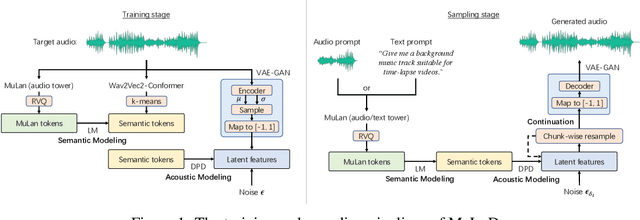
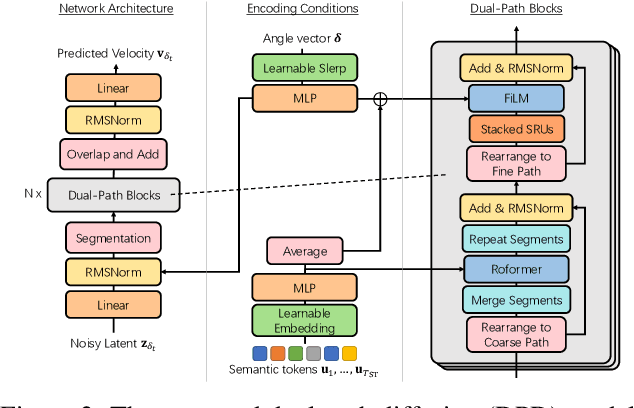

Abstract:Recent progress in music generation has been remarkably advanced by the state-of-the-art MusicLM, which comprises a hierarchy of three LMs, respectively, for semantic, coarse acoustic, and fine acoustic modelings. Yet, sampling with the MusicLM requires processing through these LMs one by one to obtain the fine-grained acoustic tokens, making it computationally expensive and prohibitive for a real-time generation. Efficient music generation with a quality on par with MusicLM remains a significant challenge. In this paper, we present MeLoDy (M for music; L for LM; D for diffusion), an LM-guided diffusion model that generates music audios of state-of-the-art quality meanwhile reducing 95.7% or 99.6% forward passes in MusicLM, respectively, for sampling 10s or 30s music. MeLoDy inherits the highest-level LM from MusicLM for semantic modeling, and applies a novel dual-path diffusion (DPD) model and an audio VAE-GAN to efficiently decode the conditioning semantic tokens into waveform. DPD is proposed to simultaneously model the coarse and fine acoustics by incorporating the semantic information into segments of latents effectively via cross-attention at each denoising step. Our experimental results suggest the superiority of MeLoDy, not only in its practical advantages on sampling speed and infinitely continuable generation, but also in its state-of-the-art musicality, audio quality, and text correlation. Our samples are available at https://Efficient-MeLoDy.github.io/.
Differentiable Wavetable Synthesis
Nov 23, 2021

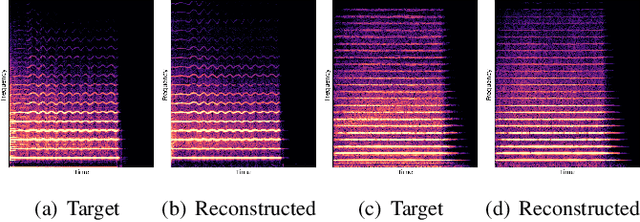
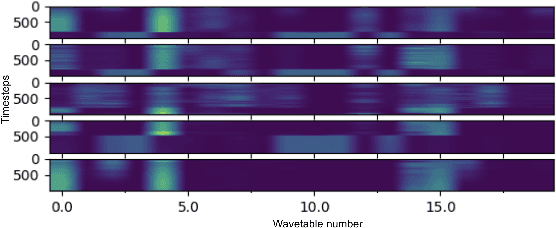
Abstract:Differentiable Wavetable Synthesis (DWTS) is a technique for neural audio synthesis which learns a dictionary of one-period waveforms i.e. wavetables, through end-to-end training. We achieve high-fidelity audio synthesis with as little as 10 to 20 wavetables and demonstrate how a data-driven dictionary of waveforms opens up unprecedented one-shot learning paradigms on short audio clips. Notably, we show audio manipulations, such as high quality pitch-shifting, using only a few seconds of input audio. Lastly, we investigate performance gains from using learned wavetables for realtime and interactive audio synthesis.
Supervised Chorus Detection for Popular Music Using Convolutional Neural Network and Multi-task Learning
Mar 26, 2021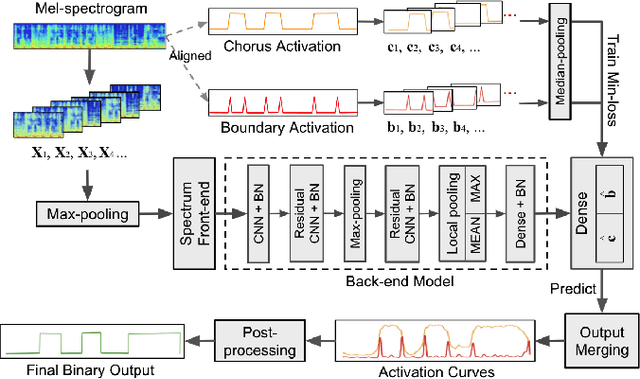
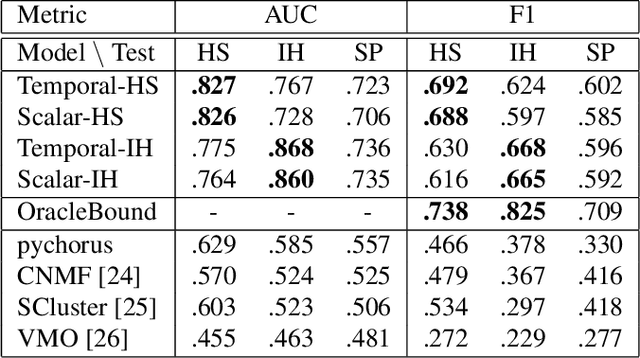
Abstract:This paper presents a novel supervised approach to detecting the chorus segments in popular music. Traditional approaches to this task are mostly unsupervised, with pipelines designed to target some quality that is assumed to define "chorusness," which usually means seeking the loudest or most frequently repeated sections. We propose to use a convolutional neural network with a multi-task learning objective, which simultaneously fits two temporal activation curves: one indicating "chorusness" as a function of time, and the other the location of the boundaries. We also propose a post-processing method that jointly takes into account the chorus and boundary predictions to produce binary output. In experiments using three datasets, we compare our system to a set of public implementations of other segmentation and chorus-detection algorithms, and find our approach performs significantly better.
 Add to Chrome
Add to Chrome Add to Firefox
Add to Firefox Add to Edge
Add to Edge